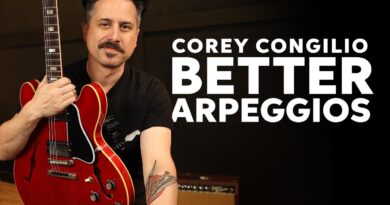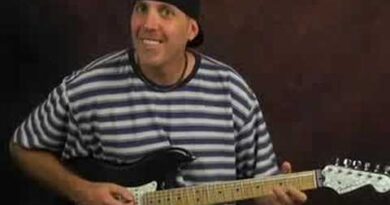Guitar Scales – Shapes VS Theory!
???? Break through the lost intermediate plateau in 2023 – Bulletproof Guitar Player 2.0 coming soon ➡️ https://bit.ly/Bulletproof2023 ???? MY ONLINE COURSES ⬇️
✅ Bulletproof Guitar Player Part 1: Master the Fretboard – http://bit.ly/BGPPart1
✅ Bulletproof Guitar Player Part 2: Advanced Concepts – http://bit.ly/BGPPart2
✅ Spicy Licks Package 1 (10 Licks Inspired by Joe Bonamassa & Eric Johnson): http://bit.ly/SpicyLicksPackage1
Progress to an advanced level of guitar playing – http://bulletproofguitarplayer.com I thought I’d revisit the idea of scale shapes and how they relate to music theory. A while ago I made a video about why I don’t teach methods like 3NPS (three note per string) and CAGED, and instead opt for an alternative method. Some people seemed to think from watching that video that I don’t advocate for the use of scale shapes at all, which is definitely not the case, so I thought I’d clear some things up in this video.
If you liked this video, hit the like button and click ‘Subscribe’ for more!
FOLLOW ME ON SOCIAL MEDIA
FACEBOOK: https://www.facebook.com/rcampbellguitarist/
INSTAGRAM: https://www.instagram.com/rosscampbellguitarist/
TWITTER: https://twitter.com/rosscampbellgtr
Thank you for watching!
R.
x
#Guitar #Scales #Shapes #Theory
Originally posted by UCo9qqlLNMHO5v0Bv5ITiqCg at https://www.youtube.com/watch?v=sB4lp3YSgzk




I completely understand everything you said makes perfect since it’s like having a tool in your tool box you must know how to use all its features in order to be completely good at using it . Ross when you make comments like that it just tells me your trying to teach me something thanks for all your content!!!
I didn't enjoy the video!
I was looking at 3NPS patterns yesterday and really in the major scale the patterns just follow the pattern of how the major scale is constructed. If you start on D you should know it is the second degree of the scale and that the 3 and 4 are a whole step and half step away after that. ITs not about the shape so much as where the intervals lie, which do form a pattern. I find that easier than CAGED, I think CAGED is better for looking at triad shapes. But that is just me. Great lesson as always.
Great lesson Ross….I'm an older guy still rockin. I don't expect or want to shred….Roger Fisher was one of the most tasteful guitarists I have ever heard and he wasn't a fast player at all….but man was he all about hitting the right notes…and even better he NEVER hit a wrong note. I'd say I'm at best intermediate….know a bit of theory and pretty good at figuring out tunes because I have a good ear. What I need is a way to learn to play what I can whistle or sing and to put that on the fretboard. I think I'm going to buy your lessons and see if you can help me I like your teaching method and the way you explain things.
…don’t forget connecting “it” to actual music! Or, putting the theory, technique, vocabulary into improvising inside of an actual song. Getting to the point where you can bridge all of these concepts into your playing. I’m personally not too far down this road, but still walking!
Sound like you need to create Bulletproof Theory Ross ;).
Why do you start a circle of 4ths from B and not C?
I never understood the CAGED vs 3–note- per-string camps (as if they're both in a war with each other, lol). I've always tried to adopt both. It's all the same fretboard, so why not explore as many ways as possible, right? Sounds like you're similarly minded in expanding the concepts. Good stuff.
By the way, I was just popping in to check out some of your videos and check out your teaching methods. I'm always trying to find a better way to get these concepts across to people who are trying to learn. Seems like you have a good system. And you have a Scottish accent. So that already puts you ahead of the curve. Rock on.
Hey Ross just subbed to your channel, great content and reviews, love the new pedalboard. Which of your courses would be best for a beginner?
Most of what you're saying implies the importance of knowing and understanding the fretboard. I believe that when one knows fretboard in and out, it's already half the job done and with much less mindless cramming.
Thanks for the videos, man. I appreciate the honesty and passion about idea while still staying open minded. Surprised more people aren't seeing these, but am glad these videos connect with me even when the ideas are somewhat beyond my realm of knowledge. The way you break things down make it where I can at least place the more advanced stuff in some sort of framework so that I can guide my guitar exploration's trajectory a little better. I guess I should buy some of your material to help support since the spicy licks are so damn spicy haha.
Great topic Ross. I've been playing for over 45 years starting in 6th grade reading music on Saxophone, and rock/blues guitar by learning fingerboard patterns. I couldn't read music on guitar but could play songs, and could read music on Sax (fingers "mapped" to note on staff) but couldn't play a song without music in front of me. Last 7 years I've played in a guitar orchestra (https://bit.ly/2pr5bMq) which forced me to sight read music on guitar. Since all scales/chords are based upon a sequence of intervals, the missing "bridge" for me was becoming fluent with intervals on the guitar. M3/m3, M5/b5,M7/b7 etc. on same, adjacent higher, adjacent lower, skipped strings etc. Helps with scales, chords and you begin recognizing them in standard notation. I'm a bit of a theory junky now and it's helped with playing, songwritiing and even my piano playing! Keep up the great vids!
New condenser? Geeez that wee studio is getting bigger and looking more fitted out every time I see it in the background. Ha ha ha. Well done pal. 🙂
Re: the topic …
Look, your playing and your highly effective teaching style speaks for itself, buddy. You don't actually have to defend yourself. There's nothing wrong with breaking with convention/the fraternity and putting forward a new approach or thought process. It's challenging the conservatoria.
Scientists do it all the time to test theories among peers.
It's called LATERAL thinking.
Plus we are all still learning from each other. Feedback is good and some we can use to improve but much of online push back can be out of misunderstanding.
I personally understood your aim in that video back then
And in the end if you stand out from the White Noise of all the other teachers and 'lesson' videos online, which you do buddy, then wtf is wrong with that?
You don't get to afford new condensers and better teaching spaces/studios/tools by doing & saying the same old shit every other bugger on youtube.
So, just do YOU, buddy. You're fine. And you have MY support. 😉
Btw, I remember Frank Gambali when he was just starting out many years ago here in Australia. The family had a one of the earliest online based music stores here.
His brother Nunzio and I had many a conversation back then. Frank and I only spoke a few times but I know he is occasionally in touch with Tommy.
Anyway, you just keep going with how you do what you do pal. Never apologise. It obviously works.
Take care. Keep in touch. . (I got your email the other day. Thanks. 🙂 )
J.
A very good explanation of your thinking, thanks for taking the time. I also agree that understanding music theory is really the ideal level to reach and that "shapes" are very useful in that journey to eventually understand and apply theory. Some folks are blessed with the ability to graps theory very quickly – not me ha ha – so for me, learnig shapes has helped keep me interesed and playing while i learn theory… jsut my 2 cents.
What pre amp have you got on your SM7B mic?
I was really stuck in Pentatonic patterns for a long time. That, and one or two positions of the major scale. What is helping me to break out of that 'box' thinking somewhat ( I say 'somewhat' because there's much further to go on the endless road of creativity) is learning the Major, Minor and Modal sequences on each string. Though I'm still in the beginner/ intermediate phases of this I have definitely come to see the fretboard more clearly and I am able to know what notes are under my fingers at any given time a whole lot easier…I also use this method to see where my intervals are in the scale by calling them out as I play…I think everyone learns differently and the key is persistence and trying to keep an open mind to ALL possibilities…I don't believe in any one set structure of learning because then it becomes 'work' and work rarely leads to the enjoyment that creating music is and should always be…Thanks for the vid's you do man…I enjoy them quite a bit, especially because of your keeping the focus on learning and not on a 10-minute sales pitch like so many others do…
Odd question, what is the EQ setting you have going on on the screen behind you? Another great video and point made btw!
When I was 13 I took some guitar lessons. After a couple of weeks I asked how I could learn all the notes on the guitar. He showed me a diagram of the neck with all the notes. I took it home and kept staring at it, trying to memorize it. About a week later I sold my guitar and ran away from home! Years later I figured out that while there’s 144 places to play a note, most are repeats. You really only need to know about 21 to 36 of them. Then learn how to put them together. (Theory) Your courses are very good. You remind me of the instructor I finally found who actually new how to teach! Thanks.
I've never been a huge fan of the 3-NPS method because it seems to throw me off of position playing.
Does anyone know if he has a lesson on the circle of 4ths, like he was talking about in this video?
I thought I had reached my peak on guitar after almost 20 years struggling to get a grip on the thing, drums were so much easier, listen to the tunes a couple of times and count it off and it's there on drums, but guitar with no guitar teacher and no Internet was really difficult to work out, I got the opportunity to go to college and study music In my mid 40's,
Mindblown is an understatement in explaining how theory has not only made years of stuff I'd struggled with look piss easy but theory knowledge has taken all notion of the guitar being difficult and turned it on its head
Stop justifying yourself man you’re great ! F**k the haters we love you ????????????????????
Excellent lesson!
I am an older guy and before you tube came along I knew absolutely zero about theory. This was because I have never had a teacher and could not suss anything by books. But guys like yourself have seriously improved my playing just by teaching me the little theory I know now. For this I am truly grateful. Thanks.
Totally agree, I went more down the scale shape pattern and now I'm having to go back and learn the theory as it applies to the guitar
Your online courses are helping a great deal with that mind 🙂